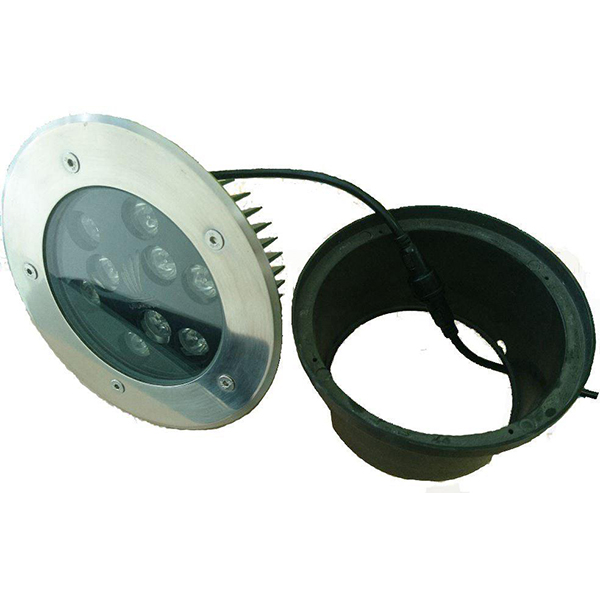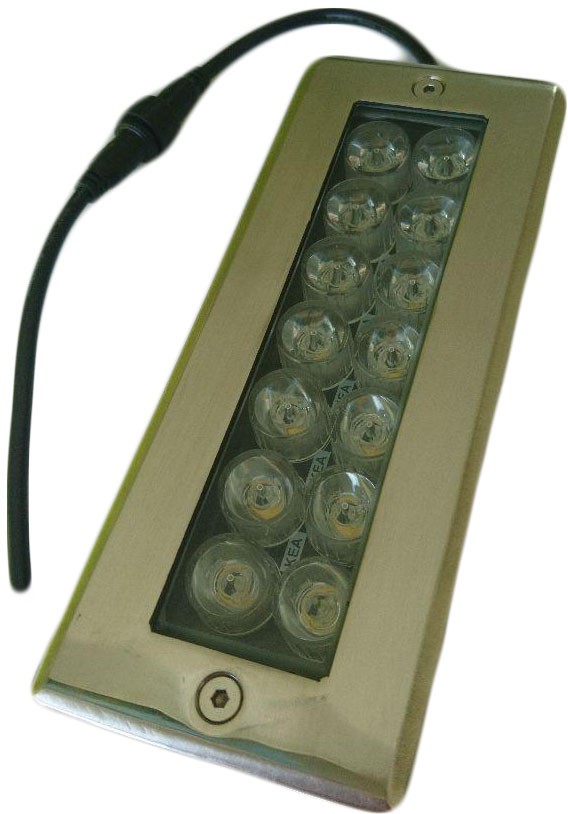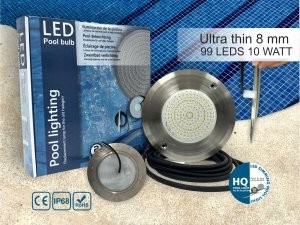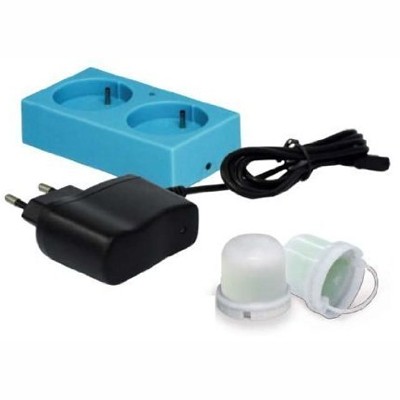Pool Light
Pool lights with optimal lighting and illumination bring a beautiful and pleasant atmosphere to enjoy the beauty of the pool at night. The following content provides information about models and best prices for all types of pool lights.
Pool Light Expert Buying Guide and Price List
In general, pool lights or projectors are produced and supplied in two models: one with a bowl and one without a bowl.
Nowadays, many builders and employers have aroused the attention and admiration of the visitors and users of the pools, especially at night, by using pool lights and their beautiful lighting as one of the beautiful complementary decorations in the area. Pool lights or projectors are usually LED and SMD.
In terms of material, the frame of the pool lights has a variety of steel or compressed plastic, and in terms of size, they are usually produced and supplied in diameters of 10, 15, 20, and 30 cm.
Steel body pool lights are usually multi-color or 7 colors and use about 12 watts of electricity.
Compressed plastic body pool lights are older and have both 6 watts (white color) and 12 watts (multi-color).
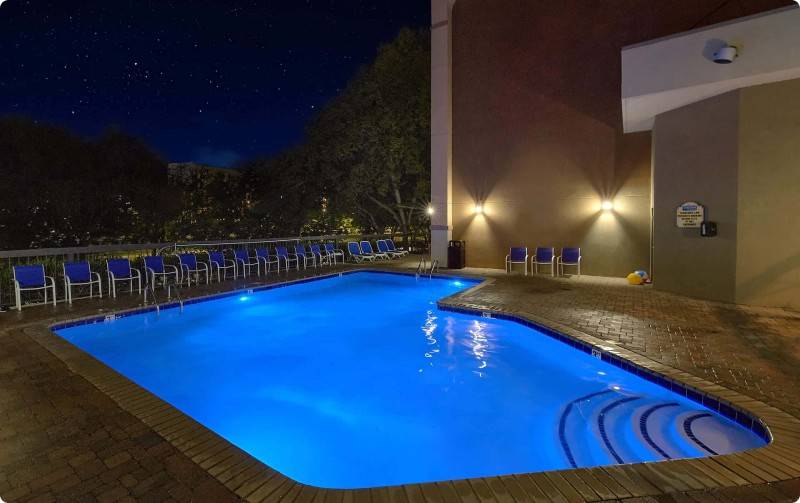
Points and Tips for Using Pool Lights
The following points will help you to use pool lights correctly:
- Before installing/replacing the lights, even though the current is 12 volts in this area, it is necessary to lower the water level of the pool or hot tub at least to the bottom of the bowl of the lights (impenetrable to water). It can be done safely and correctly at the place where the electric wires of the lights are connected.
- The number of LEDs installed in each pool light is usually 3, 6, 12, and 15.
- Before replacing your old pool lights, first make sure that the lights' power supply is working properly.
- When buying a replacement pool light, in addition to paying attention to the diameter and type of the previous pool light, you should pay attention to the previous pool light color and wiring to know if it's 2-wire or 4-wire. It is recommended to take a picture of the previous pool light to prevent further mistakes.
- If multi-color pool lights are used, the wiring of the pool lights should be 4 (you can also use a 2-to-4 wire conversion for each light).
- The distance between the pool lights depends on their brightness level (the minimum distance is usually 3 to 4 meters).
Types of Pool Lights
The types of standard pool lights are as follows:
Incandescent Pool Light
In the past, string pool lights were a good option for consumers due to their reasonable price and bright yellow color (daylight). These lights produce a warm yellow glow by heating a filament.
Energy-saving lights, or CFLs, have replaced incandescent lamps, but these lights still retain their appeal. When the lights are turned on, the pool water appears green, and the yellow and blue colors combine to form a striking combination.
Nowadays, the use of incandescent lamps in swimming pools is not economically justified because they usually need to be replaced twice a year.
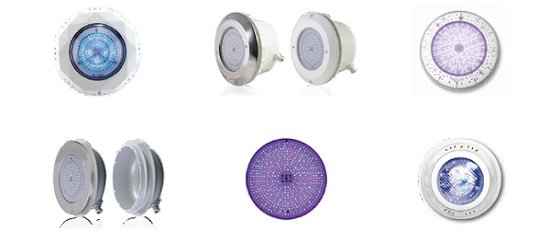
Halogen Pool Light
The advanced generation of filament lights is halogen pool lights, which consume about 20% less energy than before with the same brightness level.
Halogen lights produce a lot of heat compared to LED lights, and of course, this heat is absorbed by the pool water. Therefore, these lights should be installed and used inside the pool water.
Halogen lights have lost their appeal over the years due to higher costs, intense light, and short lifespan.
Factors to Consider When Using Halogen Pool Lights
If, for any reason, the water level of the pool decreases to the extent that the halogen lights of the pool are exposed to the air, the heat produced by them increases to such an extent that the shape of the lamp and its frame are out of the normal state and so-called deformed.
In addition, water penetrates the lamp, and its light is greatly reduced. And if the swimmer's body comes into contact with these pool lights, it will burn the swimmer's skin.
Installation of halogen pool lights must be done at a depth of 40 cm or more from the surface of the pool water because if part of the pool water is reduced by evaporation or siphoning water (to reduce the TDS of the pool water), the lights will be outside the pool. Do not place it on the surface of the pool water.
LED pool lights
The LED pool light is one of the most modern types of pool lights, which, in addition to surface installation, can also be built-in.
LED pool lights have a high efficiency (about 10 to 20 percent) with the difference that they consume only a fraction of their energy compared to other pool lights.
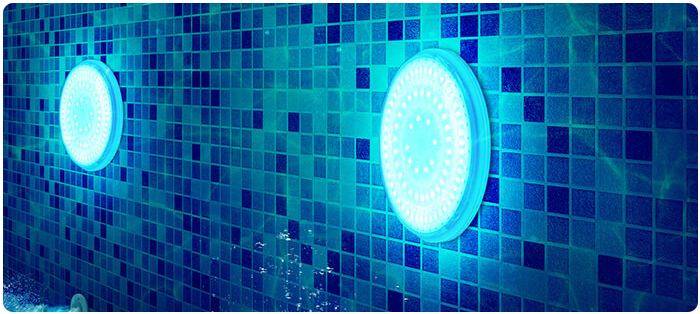
Single-color LED pool lights are usually 12 watts, and 7-color lights are usually 18 watts.
The long performance of these pool lights makes consumers unnecessary to replace them for several years.
Usually, LED pool lights last for an average of more than 50,000 hours if installed correctly and are considered one of the most widely used pool lighting options. For example, if your average use is about 30 hours per week, the lifetime of LED pool lights will reach more than 30 years!
LED pool lights are produced and supplied in many color designs, the light color of which can be controlled through the on/off switch on the panel or remote control, and in newer models through mobile phones.
Review, Selection, and Pricing of HVAC Equipment
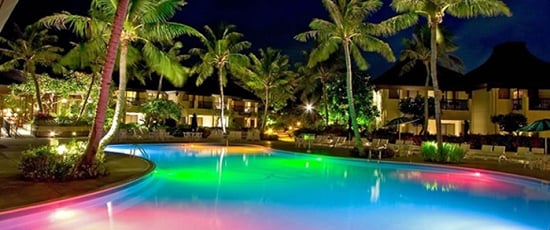
Types of Pool Lights in Terms of Installation
Pool lights are divided into two types: flush-mounted and surface-mounted.
Flush-Mounted Pool Lights
Built-in pool lights are installed in the pool wall in the corresponding concrete bowl, and their level with the pool wall makes the pool or fountain more beautiful. Today, the use of built-in LED pool lights with different colored lights (RGB) is very popular.
Important Points in Installing Flush Mounted Pool Lights
The installation location of built-in pool lights should be determined and placed at the time of concreting the construction of the pool.
After concreting the pool bowl, the appropriate cable with the lamp model is selected and pulled inside the pool wall. Be careful to keep enough cable to install the light so that the light is properly placed.
In addition, if you want to use and install built-in colored LED lights with the ability to change the color of the light (7 colors) in the body of your pool, you must use built-in 4-strand cables at the beginning of the work.
The most important step after installing the lamp is the complete sealing of the cables stretched inside the pool shell. Be sure to seal the connection point of this cable with the pool light with tape. Otherwise, water will penetrate the lamp through the cable and cause the lamp to fail.
Note:
When installing the pool lights, be sure to pay attention to the fact that the inside of the lamp bowl should not be filled with aquarium glue (for better sealing) by the installer because this action will reduce the pool water flow behind the light and in the short term Within a few months, it will cause your pool light to burn!
Built-in pool lights are cooled in contact with the pool water and must be installed at least 40 cm below the pool water level, except in cases where it is based on the design and construction of the related facilities at a lower depth. In addition, the built-in pool lights are usually placed at a distance of 4 to 6 meters from each other on the long sides of the pool.
Surface-Mounted Pool Lights
As its name suggests, surface-mounted pool lights are installed on the pool wall (unlike built-in lights without the need for a bowl), which has a slight protrusion compared to the surface of the pool wall. Surface-mounted pool lights have a wider light radius than built-in lights.
Safety Tips for Pool Light Installation
In general, in terms of user safety, pool lights, lighting installations, and speakers used in swimming pools are designed and produced based on two voltages of 24 and 12 volts.
Considering that in the lighting and electrical installations of swimming pools, decorative pools, jacuzzis, dry saunas, and steam saunas, due to the high conductivity of water and the wet nature of the pool space, the possibility of short circuits or causing electric shock and collateral damage is very high.
For this reason, 220V AC electricity is never used for their internal lighting, and they always replace them with halogen or LED lights with a voltage of 12V or 24V.
As you know, the effect of electric shock on the body of people whose whole or part of their body is in water is much more severe than when their body is dry on the ground and with a dry body.
The wet conditions of the pool environment make swimmers in the pool, much more vulnerable to electric shock and related hazards because the body of swimmers in the water shows much less resistance to the passage of electric current and acts as an effective path for the current to pass from the water to the ground.
For this reason, to prevent life risks for swimmers, they usually use one or more of the following methods:
- Using low-voltage electrical equipment (12 to 24 volts).
- Equipping electric circuits with fault relay and protection.
- Correct and principled insulation connection in compliance with electrical equipment standards.
- Connecting metal components (pool ladders and pool handrails, diving boards, pool lights, etc.) to equalize the potential difference, to isolate equipment and electrical circuits.
- Minimum allowed distances of some equipment and paths of electric current passing by the pools.
Notes:
The minimum distance of overhead wires in the area of outdoor swimming pools is 6 meters from the pool bowl in all directions.
The minimum distance of underground wires (burial cables) to the pool bowl is up to 2 meters (either in the indoor pool or the open pool).
The minimum distance between sockets and electrical switches to the perimeter of the pool bowl is considered to be 4 to 5 meters.
Buying Pool Lights
To choose and buy the right pool lights, in addition to the dimensions and size that should be suitable for the intended space, attention should also be paid to the surface (without bowl) and built-in (with bowl) type of lights.
On the website of DamaTajhiz HVAC, technical information on dozens of models of pool lights in various sizes and models from DamaTajhiz HVAC, Emaux, Aquamarine, Arc, HQPOOL, etc. brands, with the original warranty, for you to enjoy an optimal and smart shopping has been provided.
The Price of Pool Lights
The price of pool lights is different based on power consumption, material, operating voltage, type of operation, waterproofness, etc. On this website, you can choose the best model of pool light among dozens based on your needs and budget.
It should be noted that the prices of pool lights provided on the website of DamaTajhiz HVAC are up-to-date, and the discounts desired by consumers have been included in these prices for wholesale purchase; So that these prices also include the guarantee of the best price of DamaTajhiz HVAC.
Dear Users:
Although the history, brand strength, service, and product price are key factors when choosing a product brand. But in the field of pool deck drains and gratings, most of the users and buyers select the top-selling brands like DamaTajhiz, Emaux, Hayward, Hyperpool, Aquamarine, and so on, based on quality, price, and service.
After the sale, they choose and buy. Should you still have any questions regarding the purchase of our products, please do not hesitate and contact us at the following numbers: 103-105-106.
"Knowledge Fuels Better Choices"
Registered Trademark and Stewardship Business Licenses Issued by the Union of Virtual Business Association and the HVAC Equipment Industry.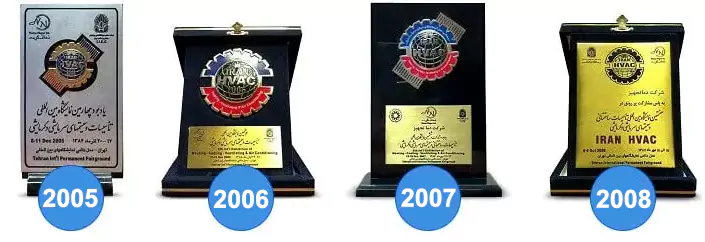
DamaTajhiz HVAC Participation at International HVAC and Construction Facilities Exhibitions Demonstrates its Global Reach and Commitment to the Industry.
We Look Forward to Your Call and the Opportunity to Meet With You
SHARE THIS CONTENT TO SPREAD THE KNOWLEDGE
| |
Head Office: No. 463,Talebian Alley,Taleghani St.Tehran,Iran


DamaTajhiz has provided the opportunity to sell and ship specialized HVAC equipment for applicants in the following countries as the first and the most popular online store for selling HVAC equipment (Heating , Ventilation , Cooling , Air conditioning) in the Middle East : Afghanistan – Tajikistan - Uzbekistan – Turkmenistan – Azerbaijan – Armenia – Georgia – Turkey – Iraq – Syria – Jordan – Kuwait – Emirates – Qatar – Oman.


